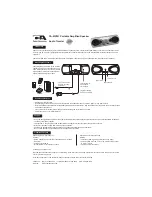
USAGE NOTES / FUNCTION
PLACE AND EXTEND THE LOAD ON THE STAND
IMPORTANT!
Do not underestimate the weight of the loudspeaker
- The placement, extension and retraction of the loudspeaker must be
-
performed by physically fit technicians.
- Firmly grasp the distance rod when adjusting the height to the desired
-
position
12
and lock in the locking pin
16
.
- The distance rod end is in the form of a cone formed peg, the so-called
-
mounting aid makes it much easier to place the loudspeaker onto the rod
CHECK, MAINTENANCE, CLEANING
MOVING THE LOAD
Technicians:
FIRST PERSON: operates the distance rod with the speaker
12
,
17
SECOND PERSON: Operates the clamping brackets
SECOND PERSON:
a. clamp screw
13
,
18
and
SECOND PERSON:
b. locking pin
14
,
16
IMPORTANT!
Should the FIRST PERSON no longer be able to securely hold the
distance rod with the speaker attached, the SECOND PERSON must:
a. immediately tighten the clamping screw
18
,
b. and immediately let go of the locking pin
16
, so that
b.
it will automatically lock in to the closest drill hole.
EXTENDING THE LOAD
- Careful use of the stand maintains the use of the telescope and the load bearing functionality of
-
the stand, as well as the safety of the installation.
- Perform workstation maintenance only without the speaker attached and watch for eventually
-
risks (hands wedged, bumping into the stand, the speaker falls over)
- To care for the product, use a damp cloth and non-abrasive cleaning agent.
Application examples (not included in the delivery) Internal ø 35.5 mm
FIRST PERSON:
SECOND PERSON:
12
holds the (loaded) distance rod
12
with both hands
15
holds the distance rod
15
with the speakers at the
15
desired approx. height;
15
NOTE:
15
to find the pin hole easily
15
ensure that the pin
15
is located over the drill hole
15
above the clamping bracket
17
slowly lowers the distance rod
17
so that the locking
17
pin goes into the
17
correct drill hole
13
loosen the clamp screw
13
and holds it
14
pulls the locking knob
14
out of the distance rod
16
lets go of the locking knob,
16
so that it can automatically
16
go into the distance rod
18
tighten the clamp screw
18
(manual strength is enough)
RETRACTING THE LOAD
FIRST PERSON:
SECOND PERSON:
12
holds the (loaded) distance rod
12
with both hands
17
slowly lowers the
17
distance rod
17
Continues to hold the
17
distance rod so that
17
it can retract in a controlled
17
fashion.
13
loosen the clamp screw
13
just a little bit and...
14
...unlocks the locking pin
18
slowly loosens the screw
18
so that the distance rod
18
does not suddenly retract
18
rather ensuring that it
18
retracts safely and slowly.
TECHNICAL DATA / SPECIFICATIONS
FAULT-FINDING (F) and REPAIR (R)
Material
Base plate, feet, tubes: Steel, black powder coating
Thread: Steel, galvanized
Bracket: Zinc die-cast, black
Cable protection: PA-6, black
Handle: TPE, black
Load capacity
max. 20 kg*
Dimensions
Base plate: 480 x 480 x 20 mm
Rod combination: ø 42 / ø 35 mm; with mounting aid
Height: min. 1112 - max. 1812 mm
Weight
net: 12.85 kg, gross: 15 kg
Accessories
(optional)
K&M-flange adaptor (z.B. 19580, 19654, 19656)
K&M-screw-on-adaptor (24281)
K&M-sleeve adaptor 21326: ø 38 mm
Carrying case 24628 for base plate
Carrying case 21422 for Rod combination
F: The base plate
1
rocks back and forth on the floor.
F:
B: Check if the surface is even.
F:
B: Check if the base plate is even.
F:
B: Stand legs
9
are not tight, tighten with socket wrench (SW8 = M5)
F: The tube combination is not sturdy i.e. is leaning to one side.
F:
B: Check to ensure that the M-20 bolt is tight, securely screw in the tube combination
3
F:
B: Counter nut
4
is loose, tighten with Allen wrench (SW40)
7
F:
B: Check to ensure the tube combination is straight
F:
B: Ensure that the surface is even.
F: The tube combination is facing in the wrong direction
F:
B: Loosen the counter nut
4
, Place the tube combination in the desired direction
F: B:
6
and secure the position by tightening the counter nut
7
* With centric loading, on a horizontal surface and without lateral forces (wind, shocks etc.)





















